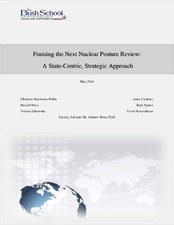| dc.description.abstract | The Nuclear Posture Review (NPR), released by the Department of Defense (DoD) in
2010, announced an unprecedented shift in the U.S. nuclear policy away from state-based threats
to nuclear proliferation and nuclear terrorism concerns. While these issues remain important, the
evolving global strategic environment dictates that the next NPR return to a state-centric, strategic
focus emphasizing four states: Russia, China, North Korea, and Iran. The only strategic peer to the
United States, Russia, is actively modernizing all aspects of its nuclear arsenal and has placed nonstrategic
nuclear weapons (NSNWs) at the center of its national security.1 China has overhauled
the structure of its nuclear weapons program and nuclear and missile developments in North Korea
are ongoing. Not long ago Iran reached the cusp of nuclear capability before the implementation
of the Joint Comprehensive Plan of Action (JCPOA). The United States must now ensure that this
agreement is implemented effectively. All of these developments make it impossible to ignore the
importance of nuclear weapons in the U.S. global strategic posture today. | en |


